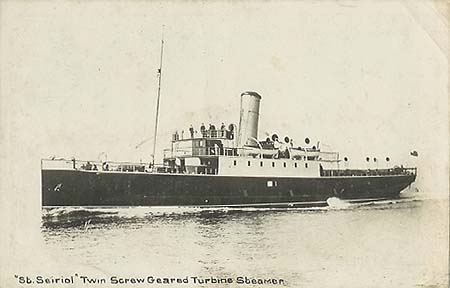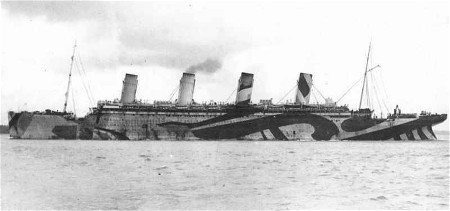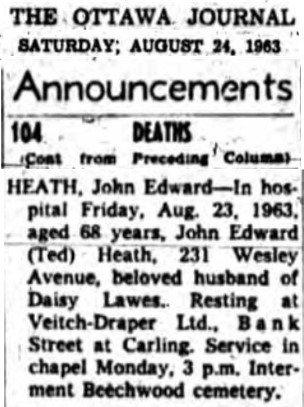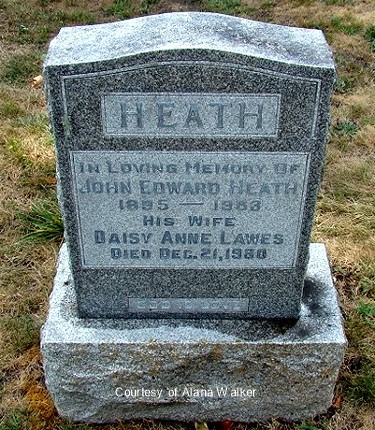|
Apr 4, 1895
|
Born in Walthamstow, England
to Thomas and Annie (nee Hart) Heath
|
|
Jun 20, 1912
|
Embarked the SS Ionian in
London as part of the Master Sedgwick party of British Home Children

|
|
Jul 4, 1912
|
Disembarked in Montreal,
Quebec and proceeded to Toronto, Ontario
|
|
Nov 6, 1914
|
Attested into the 21st
Battalion in Kingston, Ontario
Ø Number 59452 (temporary number 770)
Ø Next of kin given as Thomas Heath, 32 Queen Elizabeth
Road, Walthamstow, England
Ø Previous occupation given as Labourer
o Later noted as Boot Maker and Boiler Maker
Ø No previous military experience given
Ø Religion given as Church of England
Ø Posted to “G” Company
o This was later reorganized into “D” Company
On attesting he lied about his age,
stating he had been born April 4, 1893, not his actual birth year of 1895
The 21st Battalion trained
in the Kingston, Ontario area through the winter of 1914-15.
|
|
May 6, 1915
|
Embarked the RMS Metagama in
Montreal, Quebec

|
|
May 15, 1915
|
Disembarked in Devonport,
England and the battalion proceeded to the West Sandling Camp, near Hythe,
Kent to continue training
|
|
Sep 14, 1915
|
Embarked the St. Seiriol in
Folkestone

|
|
Sep 15, 1915
|
Disembarked in Boulogne,
France and the battalion proceeded to St. Omer
|
|
Apr 3, 1916
|
Granted 10 days leave
|
|
Apr 10, 1916
|
During fighting at the St.
Eloi Craters south of Ypres, Belgium, Private Heath was buried by the
explosion of a nearby shell. When he
was dug out he was suffering from a concussion and an injured right knee.
Admitted to the No. 4 CFA
(Canadian Field Ambulance) with a diagnosis that reads Synovitis of Right
Knee. Transferred the same day to the
No. 5 Canadian Field Ambulance
|
|
Apr 17, 1916
|
Transferred to the North
Midland Division Casualty Clearing Station at Mont des Cats, France
|
|
Apr 19, 1916
|
Transferred to the No. 15
Casualty Clearing Station
|
|
Apr 24, 1916
|
Discharged to duty and
rejoined the 21st Battalion near Voormezeele, Belgium
|
|
Aug 23, 1916
|
After developing Shell Shock
symptoms, he was Classified “TB”, meaning he was only fit for temporary base
duty and joined the CBD (Canadian Base Depot) in the Rouelles Camp, Havre,
France
|
|
Aug 31, 1916
|
Transferred to the CCAC
(Canadian Casualty Assembly Centre) in Seaford, England
|
|
Sep 4, 1916
|
Attached to the CTS (Canadian
Training School) in Bexhill for duty
|
|
Mar 10, 1917
|
Transferred to the EORD
(Eastern Ontario Regimental Depot) but remained attached to the Canadian
Training School in Bexhill
|
|
Apr 10, 1917
|
Ceased to be attached to the
school and attached to the 1st Canadian Command Depot
|
|
Apr 17, 1917
|
Attached to the Canadian
Training School in Bexhill
|
|
Apr 23, 1917
|
Attached to the 1st
Canadian Command Depot
|
|
May 18, 1917
|
Attached to the 3rd
Canadian Command Depot
|
|
Jun 26, 1917
|
Awarded the Good Conduct Badge
|
|
Jul 14, 1917
|
Ceased to be attached and
rejoined the Eastern Ontario Regimental Depot in Seaford
|
|
Jul 24, 1917
|
Attached to the 6th
Reserve Battalion in Seaford
|
|
Oct 31, 1917
|
Attached to the CDD (Canadian
Discharge Depot) in Buxton
|
|
Nov 6, 1917
|
Embarked the SS Olympic in
Liverpool

|
|
Nov 14, 1917
|
Disembarked in Halifax, Nova
Scotia and proceeded to Kingston, Ontario
|
|
Nov 22, 1917
|
Transferred to the Fleming
Convalescent Hospital in Ottawa, Ontario
|
|
Nov 27, 1917
|
Transferred to the St. Luke’s General
Hospital in Ottawa, Ontario for treatment of his right knee
|
|
Dec 10, 1917
|
To be treated as an
out-patient of the Fleming Convalescent Hospital in Ottawa
|
|
Jan 3, 1918
|
Admitted to the Fleming
Convalescent Hospital in Ottawa
|
|
Apr 18, 1918
|
Posted to the Hospital Section
of the Fleming Hospital
|
|
Apr 21, 1918
|
Transferred to the Ontario
Military Hospital in Cobourg, Ontario with a diagnosis that reads Nervous
Inability
|
|
Jun 1, 1918
|
Doctor’s notes at hospital
Ø Patient complains
of aches and pains in his body
Ø Says he feels like
he has committed a crime
Ø Talks in an
excitable manner and says the surroundings depress him
Ø Patient is inclined
to be hysterical and says the hospital is “a nut factory”
Ø Does not sleep well
and his memory is poor
Ø Says he hears shells
exploding and sees his comrades from the front
Ø He works in the
shoe repair shop in the vocational school and says the noise there gives him
headaches
Ø Thinks the hospital
is a jail
The doctor also notes that the
patient has refused Hydro Therapy and recommends he be discharged from
hospital and the military
|
|
Jun 27, 1918
|
Granted sick leave from the
hospital until July 10, 1918
|
|
Aug 17, 1918
|
Complains of sleeplessness and
is depressed. He will not discuss why
he is depressed, but when asked why he refuses to take baths he claims to
have fainted in a tub some time ago and is afraid of drowning. He is still repairing shoes in the
vocational school. He now calls the
hospital “a bug house” and the nursing sisters are his enemy.
|
|
Sep 6, 1918
|
Discharged from the Cobourg
Hospital and transferred to the Military District #3 Casualty Company in
Kingston
|
|
Sep 9, 1918
|
Discharged from the CEF in
Kingston, Ontario
Ø Rank on discharge
Private
Ø Entitled to War
Service Badge Class “A”
Ø Proposed residence
on discharge 115 Havelock Ave. E., Ottawa, Ontario
Following the end of the war,
the 1914-15 Star, British War Medal and Victory Medals were sent to him at
115 Havelock Ave. E., Ottawa, Ontario
|
|
Jun 27, 1929
|
Married to Daisy Annie Elisa
Lawes in Ottawa, Ontario
Occupation given as Canadian
National Railway Clerk
|
|
Feb 19, 1958
|
Canada Voter List shows John
Edward Heath living at 231 Wesley Ave., Ottawa, Ontario with his wife
Daisy. His occupation is listed as
Checker
|
|
Aug 23, 1963
|
John Edward Heath died while a
patient in the National Defence Medical Centre in Ottawa, Ontario and was
buried in the Beechwood Cemetery, Ottawa


|
|